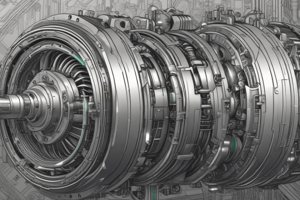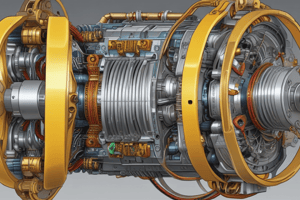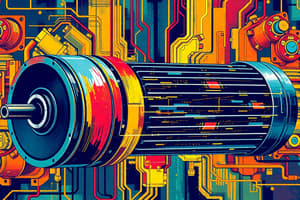Podcast
Questions and Answers
What is the main difference between a bipolar and unipolar stepper motor?
What is the main difference between a bipolar and unipolar stepper motor?
- The speed of rotation
- The number of winding phases (correct)
- The direction of rotation
- The type of current used
What is the purpose of pulses in a stepper motor?
What is the purpose of pulses in a stepper motor?
- To provide a constant current
- To change the polarity of the poles
- To control the speed of rotation
- To determine the direction of rotation (correct)
What is the advantage of a stepper motor in terms of torque?
What is the advantage of a stepper motor in terms of torque?
- They have no torque
- They have variable torque
- They have low torque
- They have high torque (correct)
What is the main difference between a brushless DC motor and a brushed DC motor?
What is the main difference between a brushless DC motor and a brushed DC motor?
What is the role of the controller in a brushless DC motor?
What is the role of the controller in a brushless DC motor?
What is the advantage of a brushless DC motor in terms of efficiency?
What is the advantage of a brushless DC motor in terms of efficiency?
What is the difference between an inner rotor and outer rotor design in a brushless DC motor?
What is the difference between an inner rotor and outer rotor design in a brushless DC motor?
What is the advantage of a brushless DC motor in terms of noise?
What is the advantage of a brushless DC motor in terms of noise?
What is the advantage of a brushless DC motor in terms of acceleration and deceleration?
What is the advantage of a brushless DC motor in terms of acceleration and deceleration?
What is the advantage of a brushless DC motor in terms of torque per unit volume?
What is the advantage of a brushless DC motor in terms of torque per unit volume?
Flashcards are hidden until you start studying
Study Notes
Characteristics of DC Motors
- Three characteristic curves are important for DC motors:
- Torque vs. armature current
- Speed vs. armature current
- Speed vs. torque
- These characteristics are determined by the relations: Ta ∝ ɸ.Ia and N ∝ Eb/ɸ
- Back emf (Eb) is given by the emf equation of a dc generator: Eb = PɸNZ / 60A
Characteristics of DC Series Motors
- Torque vs. armature current (Ta-Ia):
- Before magnetic saturation, Ta α Ia2
- After magnetic saturation, Ta ∝ Ia
- The curve becomes a straight line after magnetic saturation
- Shaft torque (Tsh) is less than armature torque (Ta) due to stray losses
- Speed vs. armature current (N-Ia):
- Speed is inversely proportional to ɸ
- Speed is inversely proportional to Ia for small currents
- Speed becomes dangerously high when armature current is very small
- Speed vs. torque (N-Ta):
- When speed is high, torque is low, and vice versa
Characteristics of DC Shunt Motors
- Torque vs. armature current (Ta-Ia):
- Torque is proportional to armature current
- The Ta-Ia characteristic is a straight line through the origin
- Speed vs. armature current (N-Ia):
- Speed remains almost constant
- The speed decreases only by 5 to 15% of full load speed
Characteristics of DC Compound Motors
- Cumulative compound motor:
- Series winding takes care of heavy load
- Shunt winding prevents the motor from running at high speed when the load is removed
- Used in applications where high starting torque is required
- Differential compound motor:
- Total flux decreases with increase in load
- Speed remains almost constant or increases with increase in load
- Used in limited applications in experimental and research work
Speed-Torque Characteristics of DC Shunt Motor
- The speed-torque characteristics are obtained from torque-current and speed-current characteristics
- The expression for back e.m.f is given by Eb = kaϕN
- The expression for torque is given by T = kaϕIa
- The speed-torque characteristics are affected by the armature reaction
Types of Electric Breaking
- Rheostat Breaking or Dynamic Breaking:
- Armature is disconnected from the supply and connected across a breaking resistance Rb
- The motor works as a generator, producing a breaking torque
- The kinetic energy of moving parts is converted into electrical energy and dissipated in the form of heat
- Regenerative Breaking:
- The motor is operated as a generator, converting kinetic energy into electrical energy
- The electrical energy is returned to the supply source
- The motor slows down, but does not come to a complete stop
- Plugging or Reverse Current Breaking:
- The connections of the armature are reversed, providing a breaking effect
- The motor tends to rotate in the opposite direction
- The supply voltage and back emf act in the same direction, producing a high breaking torque
Comparison between Electrical Braking and Mechanical Braking
-
Cost: Electrical braking has a high initial cost, while mechanical braking has a low initial cost
-
Maintenance: Electrical braking requires very little maintenance, while mechanical braking requires frequent maintenance
-
Replacement of brake shoes: Electrical braking does not require replacement of brake shoes, while mechanical braking requires frequent replacement
-
Maintenance cost: Electrical braking has a low maintenance cost, while mechanical braking has a high maintenance cost
-
Production of metal dust: Mechanical braking produces metal dust, which causes wearing of bearings, while electrical braking does not produce metal dust
-
Braking action: Electrical braking provides a gradual and smooth braking action, while mechanical braking provides a sudden braking action
-
Heat production: Electrical braking produces heat at a convenient place, while mechanical braking produces heat in brake shoes, which may damage the brake lining
-
Regenerative braking: Electrical braking allows for regenerative braking, while mechanical braking does not
-
Used alone or supplemented: Electrical braking is alone not sufficient, and it is supplemented by mechanical braking, while mechanical braking can be used alone### Motors
-
Convert electrical energy to mechanical motion in the form of a rotor rotating around a stationary axis
-
Used in various applications, including security cameras, smart locks, and 3D printers
Stepper Motors
- Convert electrical pulses into precise mechanical motion
- Operate in discrete steps, with each step being a precise angle of rotation (typically 1.8°)
- Main components:
- Rotor: rotating component with teeth or magnetic poles
- Stator: stationary segment with coils of wire that produce magnetic fields
- Winding phases: either bipolar or unipolar, with different numbers of phases and windings
- Pulses and control: sequence of electrical pulses determines direction and distance of each step
- Highly precise and controllable, ideal for position-holding tasks, such as robotics and camera gimbals
Brushless Motor (BLDC)
- Electronically commutated DC motor without brushes
- Controller provides pulses of current to motor windings, controlling speed and torque
- Highly efficient, producing a large amount of torque over a wide speed range
- Smooth operation and holding torque when stationary
- Two main parts: rotor and stator
- Rotor: rotating part with permanent magnets
- Stator: stationary part with stator windings
Working of Brushless DC Motor
- Similar to brushed motor, but with electronic commutation instead of brushes
- Rotor magnets move the electromagnets to the stator
- High power transistors activate electromagnets for shaft turns
- Controller performs power distribution using a solid-state circuit
Types of Brushless DC Motors
- Outer rotor motor and inner rotor motor
- Main difference: design and heat dissipation
- Inner rotor design: rotor in the center, stator winding surrounds it, producing more torque and heat dissipation
- Outer rotor design: rotor surrounds the winding, trapping heat inside and operating at lower rated current
Advantages of Brushless DC Motor
- More efficient, with velocity determined by frequency of current supply
- No mechanical energy loss due to friction
- Can operate at high-speed under any condition
- No sparking, less noise, and more precise control
- Low rotor inertia, high performance, and large torque per cubic inch
- Reliable, maintenance-free, and less electromagnetic interference
- No air flow required for inside cooling
Disadvantages of Brushless DC Motor
- Cost more than brushed DC motor
- Limited high power supply, otherwise heat can damage magnets and insulation
- May weaken magnets and insulation if too much heat is generated
Studying That Suits You
Use AI to generate personalized quizzes and flashcards to suit your learning preferences.





